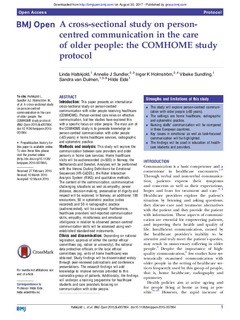| dc.description.abstract | This paper presents an international cross-sectional study on person-centred communication with older people receiving healthcare (COMHOME). Person-centred care relies on effective communication, but few studies have explored this with a specific focus on older people. The main aim of the COMHOME study is to generate knowledge on person-centred communication with older people (>65 years) in home healthcare services, radiographic and optometric practice. Methods and analysis This study will explore the communication between care providers and older persons in home care services. Home healthcare visits will be audiorecorded (n=500) in Norway, the Netherlands and Sweden. Analyses will be performed with the Verona Coding Definitions for Emotional Sequences (VR-CoDES), the Roter Interaction Analysis System (RIAS) and qualitative methods. The content of the communication, communicative challenging situations as well as empathy, power distance, decision-making, preservation of dignity and respect will be explored. In Norway, an additional 100 encounters, 50 in optometric practice (video recorded) and 50 in radiographic practice (audiorecorded), will be analysed. Furthermore, healthcare providers’ self-reported communication skills, empathy, mindfulness and emotional intelligence in relation to observed person-centred communication skills will be assessed using well-established standardised instruments. Ethics and dissemination Depending on national legislation, approval of either the central ethical committees (eg, nation or university), the national data protection officials or the local ethical committees (eg, units of home healthcare) was obtained. Study findings will be disseminated widely through peer-reviewed publications and conference presentations. The research findings will add knowledge to improve services provided to this vulnerable group of patients. Additionally, the findings will underpin a training programme for healthcare students and care providers focusing on communication with older people. | nb_NO |

